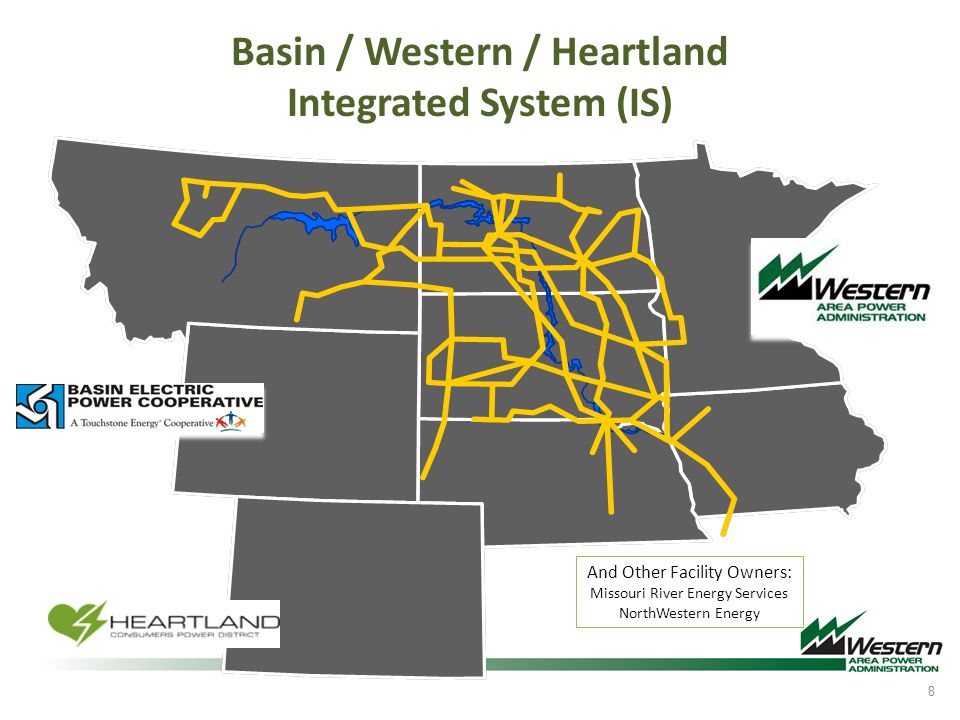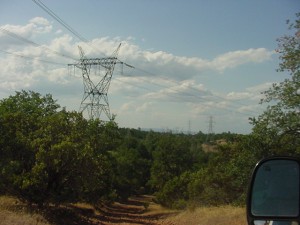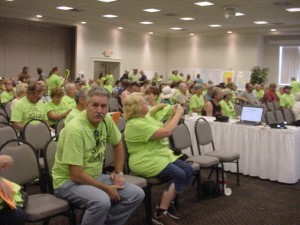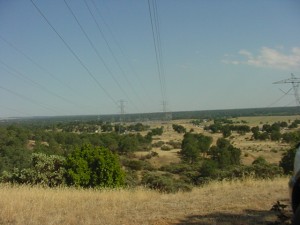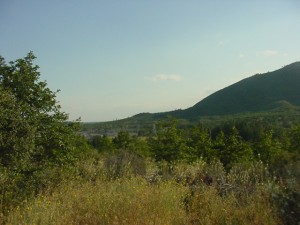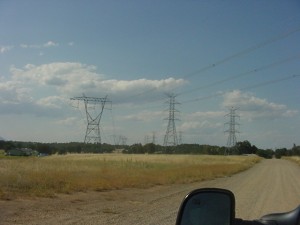Hydro power, old generation flooding the Great Plains
May 27th, 2016
50 years ago, on a family vacation, we went to Ft. Peck, stayed at Hell Creek State Park, which more than lived up to its name then, with miles and miles of nothingness, except for the Park Ranger and his trusty pup. He’d spent his day shooting rattlesnakes, he had a bagfull of them, and showed them to us, advising that we keep an eye open! The coolest, and hottest, camping experience ever. So of course I’ve wanted to go back, and this is the perfect time. It’s cool at night, and it had rained the night before, and it was SO green, blinding, and not at all like the desolate wasteland I’d remembered. Same spot 50 years later… (how did THAT happen?)
The park is in a pickle, seems there’s no money available for needed improvements, like a single phase line that’s at capacity (AACK, just found a tick! Now it’s a dead tick!), septic over capacity, and tens of thousands of folks come there to fish. They put together a “Master Plan” but it wasn’t clear the purpose, and instead of being a Master Plan, I think it was a way to set out the issues facing the Park and to try to figure out what to do about it.
Hell Creek State Park (Montana) – Comments due 11/25
I don’t get it, it’s a foreign world to me. Everyone there had a big honkin’ pick up truck, and a 5th wheel and towing a big boat that probably cost more than my house! And if they didn’t have the three part rig, they pulled a YUGE trailer and a friend pulled the YUGE fishing boat. To get there, it’s a 26 mile drive over washboard gravel, with so much dust that I don’t know if it will ever come out of the van. Washing it might induce a mudslide!
Not all that far away in miles, but a trip out and back over that long dirt road, is the Ft. Peck dam and power house, and so of course I called up and arranged a tour. Very cool, but no photos allowed. I recognized the museum, the first part of the tour, from 50 years ago, back in the days when we took family “utility infrastructure” trips. And guess who worked on the dam?
![20160524_151925[1]](https://legalectric.org/f/2016/05/20160524_1519251-1024x576.jpg) There are two power houses, one, the oldest, with three turbines and a 105 nameplate capacity, and two in power house #2, which have a 80 MW capacity. One of the turbines in unit 1 is being replaced, is much smaller, but will be much more efficient and have a higher capacity.
There are two power houses, one, the oldest, with three turbines and a 105 nameplate capacity, and two in power house #2, which have a 80 MW capacity. One of the turbines in unit 1 is being replaced, is much smaller, but will be much more efficient and have a higher capacity.
Ft. Peck is the largest earthen dam in the world! The Army Corps built a handful of dams on the Missouri, Ft. Peck, Tarrison (400 MW)(where we are now), Oahe (595 MW), Big Bend (468 M), Ft. Randall (320 MW), and Gavins Point (100 MW). Most of these are probably overdue for serious rehab.
Between all of these dams, there’s some serious power generation going on, but there’s also a problem with low water levels, putting generation at risk and requiring a FERC docket to address allocation. And of course, I was wondering where they sell the power, and it’s operated by the Army Corps to this day, and power is sold through the Pick-Sloan Missouri Basin Power Marketing Area and Western Area Power Authority (WAPA). Dispatch is supposed to happen out of a complex in Watertown, SD. Transmission out of Ft. Peck runs mostly east, but some to the west! From Ft. Peck, there are two 115kV lines, one 230 kV line, one 161 kV line, one 69 kV line, and one 34.5 kV line. Of the big collection of dams, there’s a transmission network moving the energy around:
Little is said about the impact of the flooding on the Assiniboine Nation, which met Franklin D. Roosevelt on August 6, 1934, to address those issues when he came out to cheer on the construction efforts. Now there’s “Ft. Peck” Reservation, north and east of the dam. The impacts of flooding on First Nations was part of the FERC docket regarding allocation, because a decrease in output and change in allocation will likely have an impact on local residents:
PICK-SLOAN MISSOURI BASIN PROGRAM Eastern …
From the “Answers” to comments, it seems FERC didn’t see it the same way:
And now we’re on to our second dam of the trip, Garrison Dam, and Ft. (not Grant) Stevenson, which has a great campground. Very nice, though sites are too close together. And once again, everyone has these huge rigs, some crammed in 3 to a space, circling the wagons, with a big campfire in the middle where they all hang out. I can’t help but snort, because many don’t know how to back up!!! There oughtta e a law, can’t back up — can’t go forward. And campgrounds accommodate these sorts of folks by making half the sites pull-throughs.
So anyway, on to the Soudan Mine and neutrino lab. How much fun can I stand?
TANC Board said ENOUGH! DONE!
July 16th, 2009
Yes, more good news. Yesterday, the TANC Board met, and were heard on the public conference call to vote, one by one, to put an end to this project that no one wants:
Special Op-ed: TANC’s Implosion: Lessons of Failure
And that marked the demise of what many critics called, “The Power Line to Nowhere.”
From “Silicon Valley Mercury News” (ummm, whatever happend to San Jose Mercury News?):
Controversial power line project canceled
Posted: 07/15/2009 07:00:00 PM PDT
Updated: 07/15/2009 09:05:35 PM PDT
On Monday, the Modesto and Turlock Irrigation Districts followed suit.
TANC is tanking, two more cities withdraw
July 14th, 2009
Just heard from Lisa Goza, of Stop TANC, that Modesto and Turlock dropped out, following SMUD’s withdrawal last week. That’s supposedly 70% of the $$$$ for the project — gone! Redding is hanging in there, but the STOP TANC crew is on them and… well… maybe tomorrow morning at the TANC board meeting, they’ll give it up, throw in the towel, and tank TANC. It’s so close…
This group is amazing, so many people spread out over such a great distance, and they’re so wildly diverse, united against this obscene project built on lies — they’ve exposed the TANC project for what it is, and it is falling… this is a case study in how to organize for impact.
Soon… it’s time for the silver stake!
Yolo supervisors reject transmission power lines
By LIZETH CAZARES/Lcazares@dailydemocrat.com
Created: 07/14/2009 03:49:59 PM PDT
Two more players drop out of TANC proposal
TANC rally in Redding
July 8th, 2009
I think the crowd was more like 300, full of green T-shirts and they had a successful march on the Cascade Theater. Incredible organizing by all of the many Stop TANC groups involved.
It’s tired out… gotta be on a plane first thing, at “too early o’clock”…
200 attend anti-TANC rally
And about SMUD’s withdrawal from the TANC project (which should TANK the project):
Agency Withdraws From Project
By Craig Macho
Staff Reporter
cmacho@oakdaleleader.com
209-847-3021, ext. 8128Another meeting will be held in Ripon sometime later this month.
According to a press release from TANC, outreach meetings by the agency have been put aside for now.
Greetings from California and the TANC line
July 8th, 2009
Working on tanking the TANC line — proposed by TANC, WAPA, et al — unbelievable what they’re trying to do here. The short version is at StopTANC and on this map:
More later, in the meantime, here are some photos from the scene of the crime:
We had a hoot yesterday, bouncing around in the mountains on 4 wheel trails looking at transmission, chauffered by a “fellow” truckdriver, and in the jump seat, another transmission fighter with a German Shepherd Dog! Yes, we are having fun.
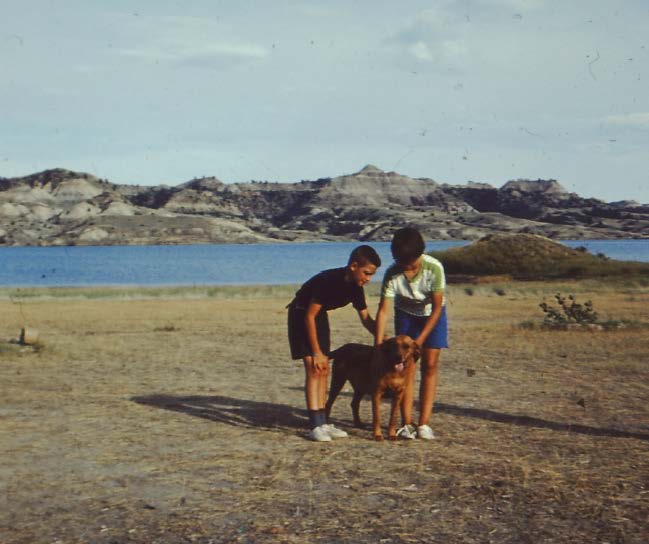
![20160525_172116[1]](https://legalectric.org/f/2016/05/20160525_1721161-1024x576.jpg)
![20160524_161657[2]](https://legalectric.org/f/2016/05/20160524_1616572-1024x576.jpg)

